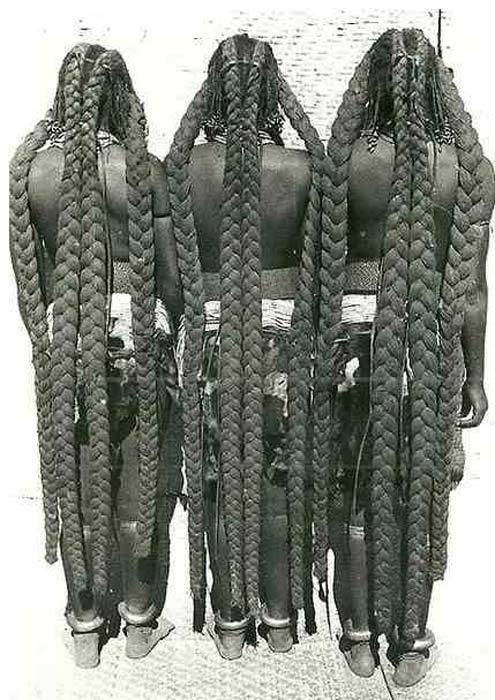^ The eembuvi-plaits of Mbalantu women before the Ohango initiation ceremony (1930s). Photo: CHL Hah
^ The eembuvi-plaits of Mbalantu women before the Ohango initiation ceremony (1930s). Photo: CHL Hahn, Collection Antje Otto The Mbalantu, who reside near the southern tips of Angola and northern border of Namibia, did not participate in agreements signed between the German Government and various tribal chiefs in 1908, enabling them to retain their traditions and skills, which can still be seen today. For the Mbalantu tribe, many of their traditions revolve around hair. As girls and women pass through various stages of life, ceremonies takes place in which their hair is prepared in particular ways to reflect their new status. One of the greatest honors for a Mbalantu tribeswomen is to reach the stage in their life when they are permitted to wear their hair as an elaborate headdress. Preparation for this stage begins around the age of twelve, when the hair undergoes special treatment to drastically speed up hair growth. First, they coat their hair in a thick paste made from the finely ground tree bark of the omutyuula tree mixed with fat. A few years later, this paste is loosened to make the hair visible. Fruit pips are then tied to the hair ends with sinew strings.When girls reach the age of sixteen, long sinew strands that reach the ground are attached to the hair. In the same year they undergo the Ohango Initiation ceremony, a living tradition with roots in the ancient past. Before the ceremony begins, their hair is styled into four long, thick braids, known as eembuvi.Once the girls complete their initiation ceremony, they are considered to be women. To celebrate this new status, their hair undergoes yet another change. A new layer of the tree bark and oil mixture is applied to the hair to once again encourage growth. (The length of the hair is so important to Mbalantu women that some were even known to buy hair from other women to attach to their own.)After the paste is applied, the long plaits were taken up and arranged into an elaborate headdress, signifying that the woman was married. “According to historical reports this headdress was a “mighty coiffure” and was so heavy that the upper ends were often attached to a piece of rope or skin, which was fastened around the forehead in order to distribute the load more evenly,” reports the Gondwana Collection. “The front edge of the coiffure known as omhatela was often decorated with a band of large, white beads (omawe gomupolo). At the back just below the omhatela a leather strip decorated with cowrie shells was also sometimes attached.”^ A beautiful young woman of the Mbalantu tribe wears her hair as a headdress, signifying that she is married. Photo: CHL Hahn, Collection Antje Otto ^ Different styles of headdress worn by the Mbalantu women. Photo: CHL Hahn, Collection Antje Otto This particular headdress was usually worn for several years after marriage. Throughout their lives they also changed the style of their headdress, often to reflect a new status, such as the birth of a child. For the women of Mbalantu, traditions around the arrangement of their hair was deeply imbued in every stage of life, from birth to puberty, marriage, child birth, and finally death. (source) -- source link
Tumblr Blog : sartorialadventure.tumblr.com
#fashion#africa#african fashion#mbalantu#angola#namibia#angolan fashion#namibian fashion#hairstyles#black hairstyles#black hair
